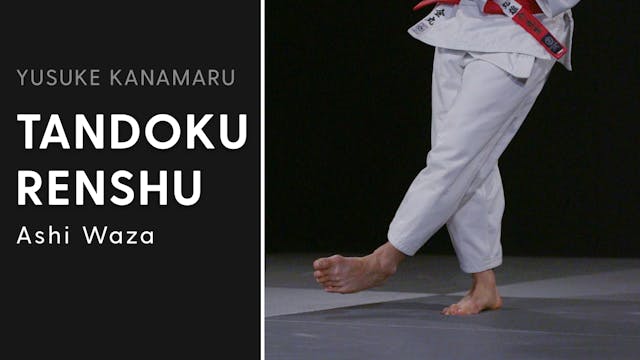There are two variations of tandoku renshu for osoto-gari, both requiring great focus on balance. The dynamic nature of osoto means it cannot be completed in a stationary position, but is performed on the move, in a line down the tatami. The more basic of the two variations involves taking a couple of steps between each repetition, allowing you to regain balance before continuing.
It is important to keep your toes pointed, to ensure you have tension in your working leg throughout. As you reap, you do a small hop, maintaining tension in the upper body. Performing the Kumi kata, you follow through with the lead shoulder and pull with the sleeve hand.
In the second variation you don’t reset. It’s one repetition immediately after the other. Timing is important, as the sequence requires alternating power in the hops, as you drive your working leg back and forth. You must maintain your balance on your supporting leg throughout. The lighter hop brings the sweeping leg forward. Once at its highest point, the more powerful hop gives impetus to drive down and sweep through the osoto movement. All the while you keep your toes pointed and sufficient tension in your upper body.
Again your hands imitate the grips, pulling on the sleeve hand and driving through the lead shoulder.
Up Next in Watch All
-
Ashi Waza | Tandoku Renshu | Yusuke K...
The practice of tandoku renshu helps improve timing, an essential component for ashi-waza. As shown here, you must maintain an upright posture and turn the sole of your sweeping foot inwards. This creates the necessary tension in your leg and allows you to comfortably catch the foot you’re attack...
-
Overview | Games & Principles | Yusuk...
In this series, Kanamaru introduces several simple games that can be employed by coaches to reinforce some of the fundamental and underlying movement principles within judo.
Where applicable, Kanamaru also demonstrates how the principles learnt from each game relate directly to Judo specific sit...
-
Hand Balance Game | Games & Principle...
The hand balance game teaches judoka how they can benefit from an opponent's action or reaction in a competitive situation.
It develops balance, decision making and reaction speed. Both judoka adopt a natural posture with their feet shoulder width apart, back straight, and head up. It's importan...




2 Comments